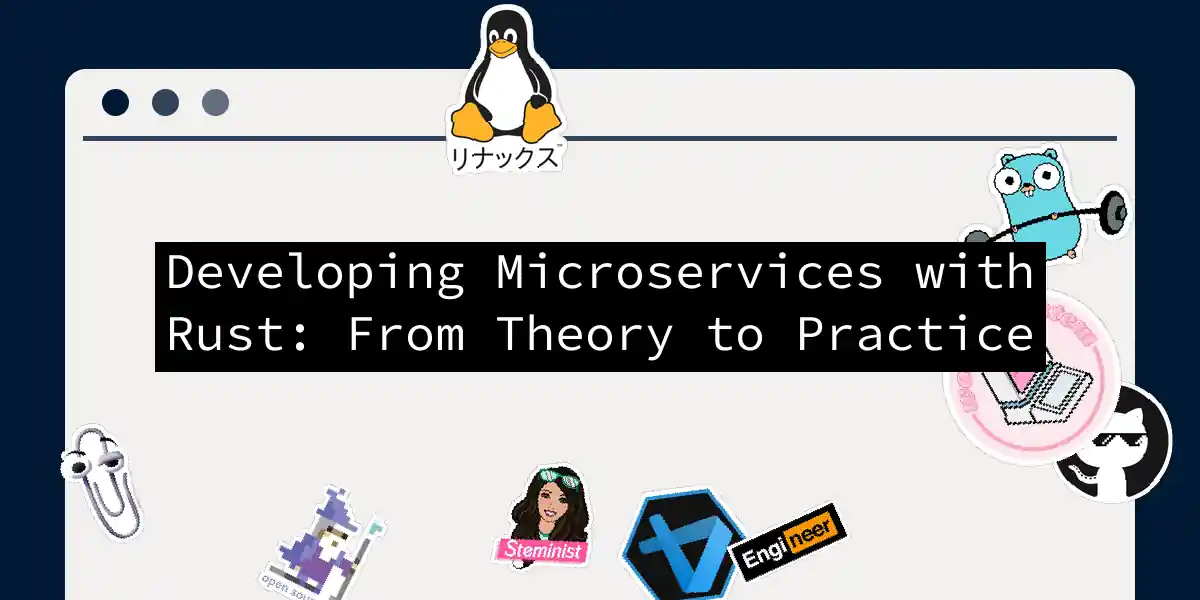Setting Up Your Rust Development Environment
Before diving into the world of microservices with Rust, you need to set up your development environment. Here are the steps to get you started:
Install Rust: If you haven’t already, install Rust using the official installation tool,
rustup.curl --proto '=https' --tlsv1.2 -sSf https://sh.rustup.rs | shChoose a Framework: For building microservices, a popular choice is the
axumframework. You can add it to yourCargo.tomlfile:[dependencies] axum = "0.6.0" tokio = { version = "1", features = ["full"] }Set Up Your Project: Create a new Rust project using Cargo:
cargo new my_microservice --bin cd my_microservice
Creating Microservices with Rust
Architecture Layers
When building microservices, it’s beneficial to follow a layered architecture. Here’s a breakdown of the typical layers you might encounter:
Domain Layer
This layer contains the business logic and rules of your application. It includes structs, traits, enums, and functions that model the problem domain.
// src/domain.rs
pub struct ToDoItem {
pub id: i32,
pub title: String,
pub completed: bool,
}
Application Layer
This layer coordinates the Domain Layer and the Infrastructure Layer. It translates user requests into actions the Domain Layer can understand.
// src/application.rs
use axum::extract::Json;
use serde::Serialize;
#[derive(Serialize)]
pub struct ToDoItemResponse {
pub id: i32,
pub title: String,
pub completed: bool,
}
pub async fn get_to_do_item(id: i32) -> ToDoItemResponse {
// Fetch the item from the database or other infrastructure
ToDoItemResponse { id, title: "Example".to_string(), completed: false }
}
Infrastructure Layer
This layer provides the necessary infrastructure to run the application, such as databases, message queues, and external APIs.
// src/infrastructure.rs
use diesel::prelude::*;
use diesel::pg::PgConnection;
pub fn establish_connection() -> PgConnection {
diesel::pg::PgConnection::establish("postgres://postgres:postgres@localhost:5432/my_db")
.expect("Error connecting to database")
}
Using axum for REST API
Here’s how you can set up a simple REST API using axum:
// src/main.rs
use axum::{
routing::get,
Router,
};
use tokio;
#[tokio::main]
async fn main() {
let app = Router::new().route("/to-do-items/:id", get(get_to_do_item));
axum::Server::bind(&"0.0.0.0:3000".parse().unwrap())
.serve(app.into_make_service())
.await
.unwrap();
}
async fn get_to_do_item(params: axum::extract::Path<i32>) -> String {
let id = params.0;
// Call the application layer function
let response = application::get_to_do_item(id).await;
serde_json::to_string(&response).unwrap()
}
Integrating Consul for Service Discovery
Service discovery is crucial in a microservices architecture. Here’s how you can integrate Consul:
Setting Up Consul
First, ensure you have Consul installed and running. You can use Docker for this:
docker run -d --name consul -p 8500:8500 consul:latest
Registering Services with Consul
You can use the consul crate to register your services:
// src/main.rs
use consul::{Client, Config};
use std::time::Duration;
#[tokio::main]
async fn main() {
let consul_config = Config::new("127.0.0.1:8500".to_string());
let client = Client::new(consul_config).unwrap();
let service = consul::Service {
id: "my_service_1".to_string(),
name: "my_service".to_string(),
port: 3000,
address: "127.0.0.1".to_string(),
..Default::default()
};
client.register_service(service, Some(Duration::from_secs(10))).unwrap();
// Your axum server setup here
}
Configuring Traefik for Dynamic Routing
Traefik can help with dynamic routing and load balancing. Here’s how to set it up:
Setting Up Traefik
You can use Docker Compose to set up Traefik:
version: '3'
services:
traefik:
image: traefik:v2.9
ports:
- "80:80"
volumes:
- ./traefik.yml:/etc/traefik/traefik.yml
- /var/run/docker.sock:/var/run/docker.sock
command: --log.level=DEBUG
my_service:
build: .
labels:
- "traefik.http.routers.my_service.rule=PathPrefix(`/to-do-items`)"
- "traefik.http.routers.my_service.service=my_service"
- "traefik.http.services.my_service.loadbalancer.server.port=3000"
Traefik Configuration
Here’s an example traefik.yml configuration:
log:
level: DEBUG
api:
dashboard: true
providers:
docker:
endpoint: "unix:///var/run/docker.sock"
exposedByDefault: false
Deploying and Scaling Your Microservices
Using Docker and Docker Compose
To deploy and scale your microservices, you can use Docker and Docker Compose. Here’s an example docker-compose.yml file:
version: '3'
services:
my_service:
build: .
ports:
- "3000:3000"
depends_on:
- db
environment:
- DATABASE_URL=postgres://postgres:postgres@db:5432/my_db
db:
image: postgres:latest
environment:
- POSTGRES_USER=postgres
- POSTGRES_PASSWORD=postgres
- POSTGRES_DB=my_db
Running Your Microservice
You can run your microservice using Docker Compose:
docker-compose up --build -d
CQRS and Event Sourcing
CQRS (Command Query Responsibility Segregation) and Event Sourcing are powerful patterns for building scalable and maintainable microservices.
CQRS
CQRS separates the read and write responsibilities of an application into separate models.
Event Sourcing
Event Sourcing involves storing the history of an application’s state as a sequence of events.
Conclusion
Building microservices with Rust involves several key components: setting up your development environment, creating the microservice architecture, integrating service discovery and dynamic routing, and deploying and scaling your services. By leveraging frameworks like axum, tools like Consul and Traefik, and patterns such as CQRS and Event Sourcing, you can create robust, scalable, and maintainable microservices.
Example Architecture Diagram
Here’s a high-level architecture diagram using the C4 model:
This diagram illustrates the system context, container diagram, component diagram, and code diagram, giving a clear overview of the microservices architecture.
By following these steps and leveraging these tools and patterns, you can build production-ready microservices in Rust that are both efficient and scalable. Happy coding
